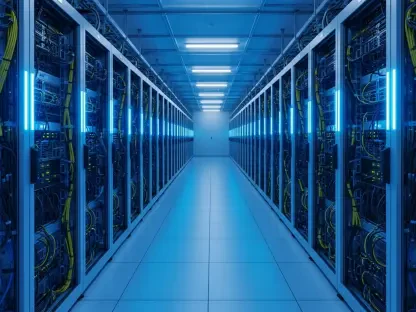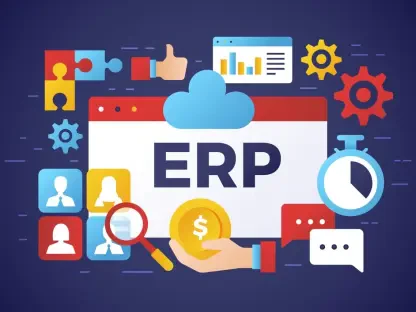In an era where cloud-based solutions power nearly every facet of business, a staggering statistic reveals the vulnerability at the heart of this digital transformation: over 90% of AI agents in Software-as-a-Service (SaaS) environments are over-permissioned, creating significant security risks. This alarming figure underscores a critical challenge as SaaS platforms become indispensable across industries, from finance to human resources. As cyber threats escalate with the integration of advanced technologies like artificial intelligence, the industry stands at a crossroads, prompting urgent calls for vendors to adopt standardized security measures to protect vast ecosystems of interconnected applications and data.
The Rising Dominance of SaaS in Modern Business
SaaS has emerged as a cornerstone of contemporary business operations, seamlessly integrating into sectors such as operations, finance, and employee management. Tools like Google Workspace, Microsoft Outlook, and Slack are now ubiquitous, streamlining workflows and fostering collaboration on a global scale. This widespread adoption reflects SaaS’s ability to drive efficiency, reduce costs, and enable scalability, making it a preferred choice for enterprises of all sizes.
Underpinning this revolution is the power of cloud computing, which serves as the technological foundation for SaaS delivery. Major players in the market have capitalized on this infrastructure to offer solutions that cater to diverse needs, positioning SaaS as a critical component of the global enterprise software landscape. The flexibility and accessibility of these platforms have cemented their role in daily business functions, often replacing traditional on-premises systems.
Moreover, the integration of emerging technologies like AI is further amplifying SaaS capabilities, enabling predictive analytics, automation, and personalized user experiences. This convergence signals a future where SaaS not only supports but also anticipates business needs. However, with such rapid growth and innovation comes the pressing need to address the security implications of this pervasive reliance on cloud-based services.
Escalating Cyber Threats in the SaaS Ecosystem
Emerging Risks and Technological Challenges
The SaaS ecosystem faces mounting cyber threats, largely driven by inconsistent security practices among vendors. Without uniform standards, platforms vary widely in their protective measures, leaving gaps that malicious actors can exploit. This lack of cohesion creates a fragmented defense landscape, making it challenging to safeguard sensitive data across interconnected systems.
Compounding these issues is the rise of agentic and generative AI tools, such as no-code and low-code platforms like Glean and n8n. While these innovations enhance productivity by automating tasks, they introduce significant risks, including over-privileged access and unintended data exposure. For instance, misconfigured AI agents can access and transfer vast amounts of information without adequate oversight, heightening the potential for breaches.
Real-world incidents further illustrate these dangers, with cases of AI agents facilitating rapid data transfers that outpace traditional user activity. Breaches involving interconnected applications have also exposed vulnerabilities, where a single compromised link in the chain can jeopardize entire networks. These examples highlight the urgent need for robust controls to mitigate the risks posed by advanced technologies in SaaS environments.
Market Data and Threat Projections
The SaaS market continues to experience exponential growth, with valuations reflecting its pivotal role in the digital economy. According to industry estimates, the market, valued at trillions today, is projected to more than triple by 2030, underscoring its transformative impact. This trajectory signals a deepening reliance on SaaS solutions across all sectors, from small businesses to global corporations.
However, this expansion is shadowed by escalating security concerns. Research indicates that a vast majority of AI agents operate with excessive permissions, creating fertile ground for cyber incidents. If left unaddressed, these vulnerabilities could erode user trust and slow the pace of SaaS adoption, as organizations grapple with the fear of data breaches and regulatory penalties.
Looking ahead, the proliferation of threats is expected to intensify as attack vectors evolve alongside technological advancements. The potential for cascading risks in interconnected SaaS applications suggests that without proactive measures, the industry could face significant setbacks. Addressing these challenges now is crucial to maintaining confidence in cloud-based solutions as a backbone of modern enterprise.
Challenges in the Shared Responsibility Model
The shared responsibility model, a cornerstone of SaaS security, often places an uneven burden on customers to secure their environments. Vendors frequently delegate significant aspects of protection to users, expecting them to manage configurations and monitor threats. This imbalance creates a disparity, as many organizations lack the resources or expertise to handle such complex responsibilities effectively.
Customers face additional hurdles in navigating a landscape of numerous applications, each with inconsistent security controls and limited visibility into settings. This fragmentation complicates efforts to maintain a secure posture, as identifying and addressing vulnerabilities across platforms becomes a daunting task. The result is a heightened risk of oversight, where critical gaps in defense go unnoticed until exploited.
Potential solutions lie in rebalancing this model through vendor-driven initiatives. Providing tools for enhanced telemetry and accessible configuration APIs could empower customers with greater control and insight. Such measures would distribute accountability more equitably, fostering a collaborative approach to security that benefits both parties in the SaaS ecosystem.
The Push for Standardized Security Frameworks
Amid growing concerns, the industry is witnessing a concerted push for standardized security frameworks to address systemic vulnerabilities. The SaaS Security Capability Framework (SSCF), developed through efforts by key organizations, offers a structured approach to evaluate and enhance platform security. This framework aims to establish consistent benchmarks that vendors can follow to protect users and data.
Despite its potential, adoption of such frameworks remains limited among SaaS providers. Many continue to operate under custom security practices, undermining efforts to create a unified defense strategy. This reluctance poses a significant barrier to improving overall cybersecurity, as the absence of standardization perpetuates risks across the ecosystem.
Customer advocacy and cross-industry collaboration are emerging as vital forces in driving change. Initiatives like forming working groups to pressure vendors for compliance highlight the power of collective action. By uniting security leaders and stakeholders, these efforts aim to compel providers to prioritize framework adoption, ensuring that security becomes an integral component of SaaS offerings.
Future Outlook for SaaS Security in a Digital World
As cyber threats continue to evolve, the SaaS industry must brace for a future shaped by increasing complexity and interconnectivity. Emerging attack vectors, fueled by sophisticated techniques, are likely to target the intricate web of applications that define modern SaaS environments. Staying ahead of these risks will require continuous adaptation and vigilance from all stakeholders.
Technological advancements, particularly in AI, promise to both challenge and enhance security practices. While these tools can introduce new vulnerabilities, they also offer opportunities for innovative defenses, such as automated threat detection and response. Harnessing these capabilities will be essential to fortify SaaS platforms against the next wave of cyber dangers.
Ultimately, the path forward hinges on a commitment to vendor accountability and global cooperation. Strengthening security through shared standards and collaborative innovation can transform the SaaS landscape into a safer space for users worldwide. The industry’s ability to balance progress with protection will determine its resilience in an increasingly digital world.
Conclusion: A Call to Action for SaaS Security
Reflecting on the insights gathered, it becomes evident that the SaaS industry has reached a critical juncture where security can no longer be an afterthought. The discussions around escalating threats and the uneven shared responsibility model paint a clear picture of an ecosystem in need of urgent reform. Vendors must step up, and customers demand more transparency to navigate the risks of a hyper-connected digital landscape.
Moving beyond the challenges identified, actionable steps emerge as the next focus for all involved. Vendors are encouraged to embed security by default, integrating standardized frameworks like the SSCF into their core operations. Simultaneously, customers need to push for greater visibility into configurations and advocate for tools that simplify securing their environments.
Looking ahead, fostering a culture of collaboration stands out as a vital consideration. Establishing cross-industry partnerships and maintaining open dialogue between vendors and users promise to build a foundation of trust. This collective effort aims to ensure that as SaaS continues to innovate, it does so with robust safeguards, protecting the future of digital business from emerging threats.









